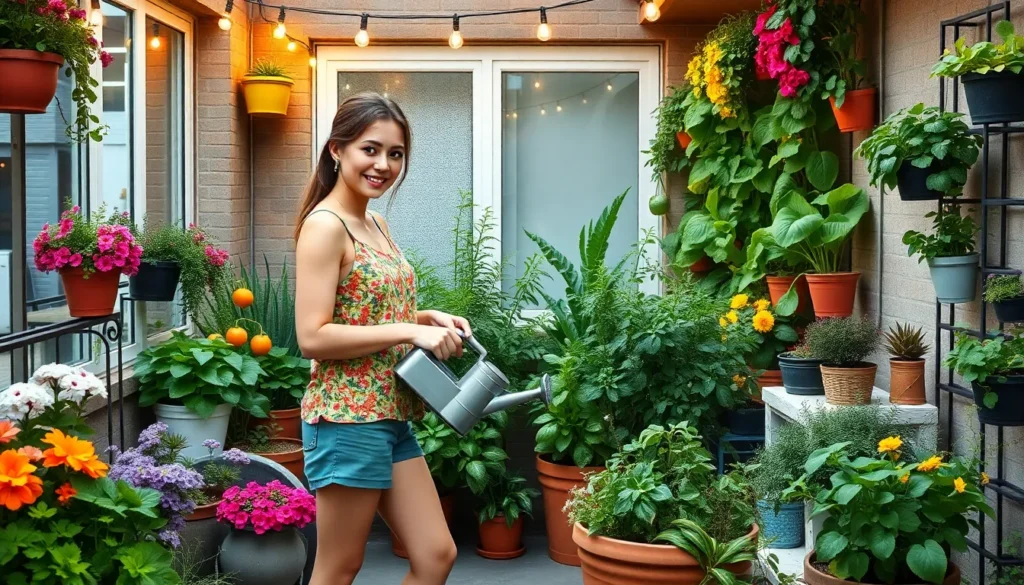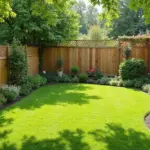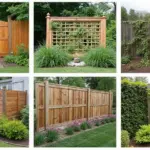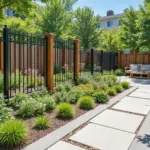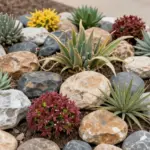Living in an apartment doesn’t mean we have to give up our dreams of creating a beautiful garden oasis. Patio gardening has become the perfect solution for urban dwellers who crave fresh herbs, vibrant flowers, and lush greenery right outside their door.
We’ve discovered that even the smallest balcony or patio can transform into a stunning garden retreat with the right approach. From vertical growing systems that maximize space to clever container arrangements that create visual impact, there are countless ways to bring nature into our apartment living experience.
Whether we’re working with a tiny juliet balcony or a spacious terrace, the key lies in choosing the right plants, containers, and design strategies that suit our exact space and lifestyle. Let’s explore how we can turn any apartment patio into a thriving garden paradise that’ll make our neighbors green with envy.
Transform Your Small Apartment Patio Into a Garden Paradise
Creating a thriving garden sanctuary on your apartment patio starts with smart planning and thoughtful design choices. We’ll guide you through the essential steps to maximize your outdoor space’s potential.
Assess Your Space and Sunlight Conditions
Measure your patio dimensions to determine how much growing space you have available. Most apartment patios range from 4×6 feet to 8×10 feet, giving you roughly 24 to 80 square feet of gardening potential.
Track sunlight patterns throughout the day by observing which areas receive direct sun, partial shade, or full shade. Note the duration of sunlight exposure in each zone, as this determines which plants will thrive in exact locations.
Identify microclimates within your patio space by checking for wind patterns, heat reflection from walls, and moisture retention areas. These factors affect plant growth and help you position containers strategically.
Document weight restrictions by checking your lease agreement or building regulations for balcony load limits. Standard apartment balconies typically support 50-100 pounds per square foot, including furniture and planters.
Map utility access points such as water sources, electrical outlets, and storage areas to plan your garden layout efficiently. Position heavy containers near structural support beams when possible.
Choose the Right Patio Garden Style for Your Lifestyle
Select a container garden approach if you prefer flexibility and easy maintenance. This style works best for renters who might relocate or want to rearrange plants seasonally.
Opt for vertical gardening systems when floor space is limited but wall area is available. Wall mounted planters, trellises, and hanging baskets maximize growing capacity in compact areas.
Create themed garden zones by grouping plants with similar care requirements together. Examples include herb gardens, succulent displays, or flowering plant collections that match your cooking or aesthetic preferences.
Design a low maintenance setup using drought tolerant plants like lavender, rosemary, and sedums if you travel frequently or have a busy schedule. These plants require watering only once or twice weekly.
Plan seasonal rotation gardens by choosing containers that accommodate different plants throughout the year. Spring vegetables can transition to summer flowers, then fall herbs, keeping your patio garden ever-changing and productive.
Maximize Vertical Space With Creative Container Gardens
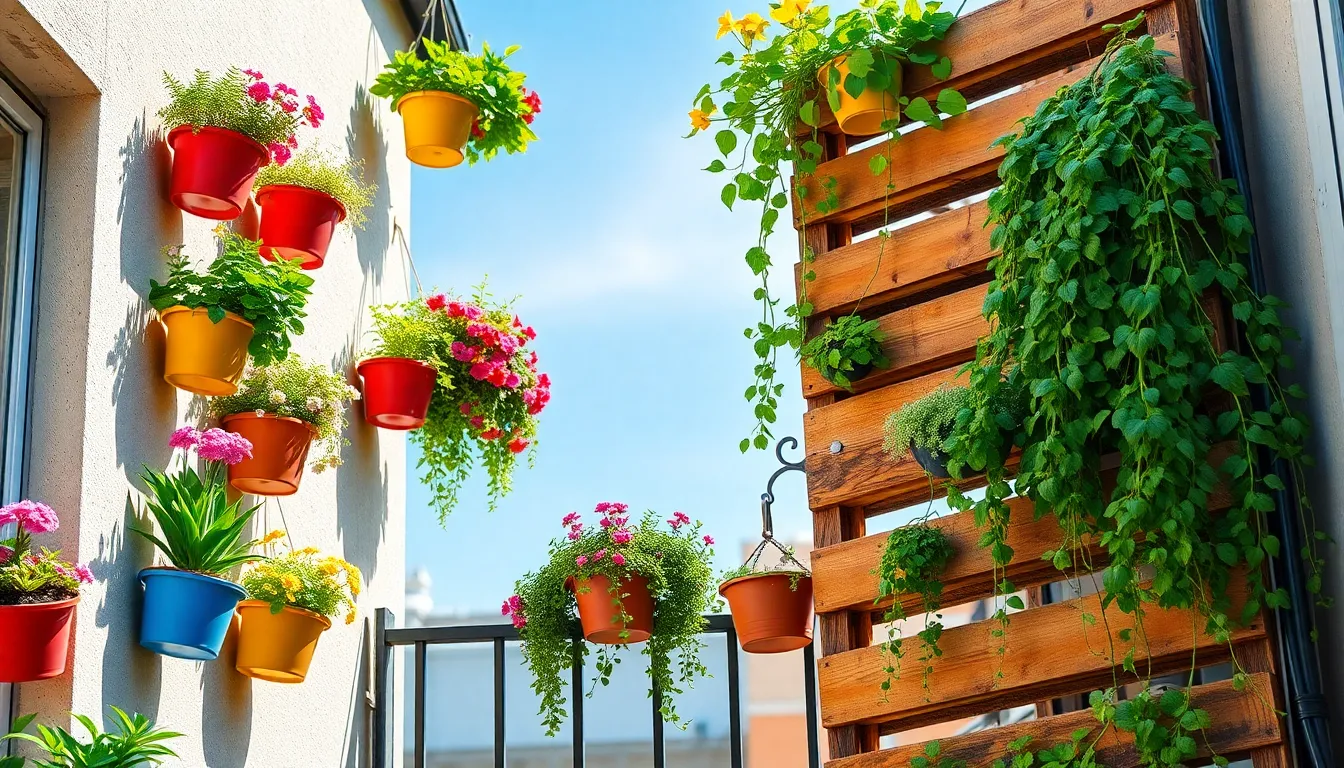
Vertical planters transform small patios into productive growing spaces by stacking multiple levels of plants in a single footprint. We can significantly increase our growing capacity while maintaining the flexibility to grow herbs, vegetables, and decorative plants together.
Install Wall-Mounted Planters and Hanging Baskets
Attach planters directly to balcony walls to create stunning vertical garden displays that maximize every inch of available space. We recommend mounting shelves, pots, or specialized wall planters to support herbs, annual flowers, and trailing plants that cascade beautifully downward.
Use overhead ceiling hooks to hang baskets filled with flowering plants or trailing vines that add layers of greenery without sacrificing precious floor space. These hanging gardens create visual depth while keeping pathways clear for movement and furniture.
Transform balcony railings into plant supports by covering them with chicken wire or installing railing-mounted hangers that hold climbing plants. This technique beautifies the space while providing natural shade and privacy from neighboring units.
Build DIY Vertical Garden Towers and Trellises
Construct vertical garden towers from repurposed materials to hold multiple containers stacked efficiently in a small footprint. We can build these towers using materials like wooden pallets, PVC pipes, or metal frames that support several pots vertically.
Install trellises along walls or railing edges to support climbing plants like peas, beans, and flowering vines that grow upward rather than outward. These structures add important height and greenery without requiring large amounts of floor space.
Combine multiple vertical elements by integrating trellises with container gardens and hanging planters to create multi-dimensional garden spaces. This layered approach transforms even the smallest balconies into lush, productive garden retreats that use every available vertical surface.
Choose lightweight materials like composite, resin, vinyl, or plastic containers instead of heavy terracotta or ceramic options to reduce weight concerns on balconies. Lightweight planters also make rearranging and seasonal changes much easier to manage.
Select Low-Maintenance Plants Perfect for Apartment Patios
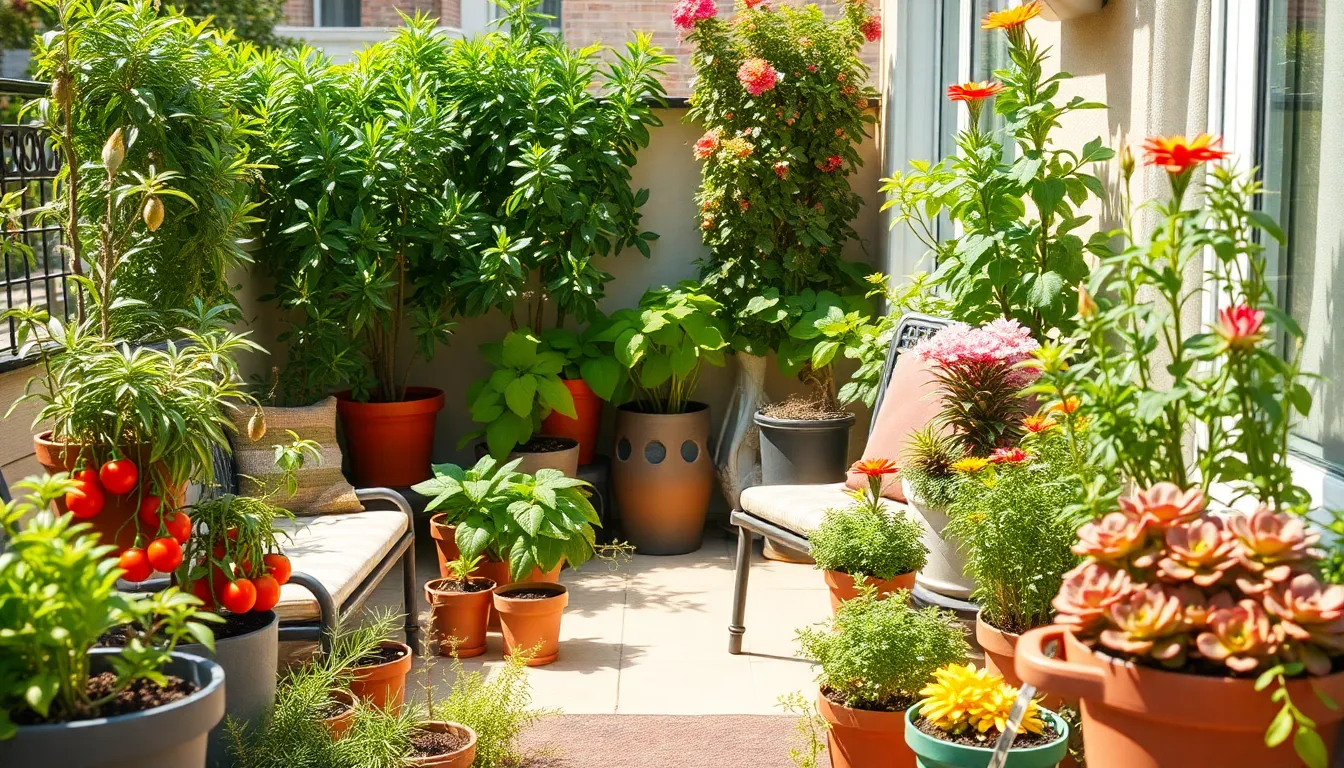
Creating a thriving patio garden doesn’t require endless hours of maintenance when you choose the right plants. We’ll guide you through selecting plants that flourish with minimal care while maximizing your apartment’s outdoor space.
Choose Herbs and Vegetables for Edible Patio Gardens
Herbs provide fresh flavors while requiring minimal upkeep in container gardens. Rosemary thrives in pots with occasional watering and plenty of sunlight, making it perfect for busy apartment dwellers. Garden sage prefers full sun and dry soil conditions, needing minimal watering and pruning to maintain its sturdy growth in outdoor containers.
Vegetables can transform your patio into a productive food source with the right selections. Cherry tomatoes grow exceptionally well in containers when they receive sufficient sunlight throughout the day. Peppers adapt beautifully to pot cultivation and produce abundant harvests with regular watering and periodic trimming.
Lettuce offers quick growing cycles and compact growth habits that suit small patio spaces perfectly. These edible plants stay manageable through periodic harvesting, which actually encourages continued production throughout the growing season.
Pick Flowering Plants That Thrive in Containers
Flowering plants bring vibrant colors to apartment patios without demanding extensive care routines. Succulents like echeveria, sedum, saxifraga, and hens and chicks excel in sunny, dry conditions while requiring infrequent watering schedules.
Sunny patio locations support beautiful blooms from bee balm, lavender, hardy geranium, and daylilies that tolerate container growing conditions. Winter jasmine produces fragrant flowers while tolerating various soil types with minimal upkeep requirements.
Partial shade areas benefit from hydrangeas, lady ferns, and chaenomeles that adapt well to container environments. Impatiens and coleus provide colorful foliage and continuous blooms without heavy maintenance demands.
Low maintenance flowering plants respond well to simple care practices. Regular deadheading encourages continued blooming while occasional pinching promotes denser, bushier growth patterns. Hostas and ferns adapt exceptionally well to container growing and thrive with basic watering routines.
Create Privacy and Ambiance With Strategic Plant Placement
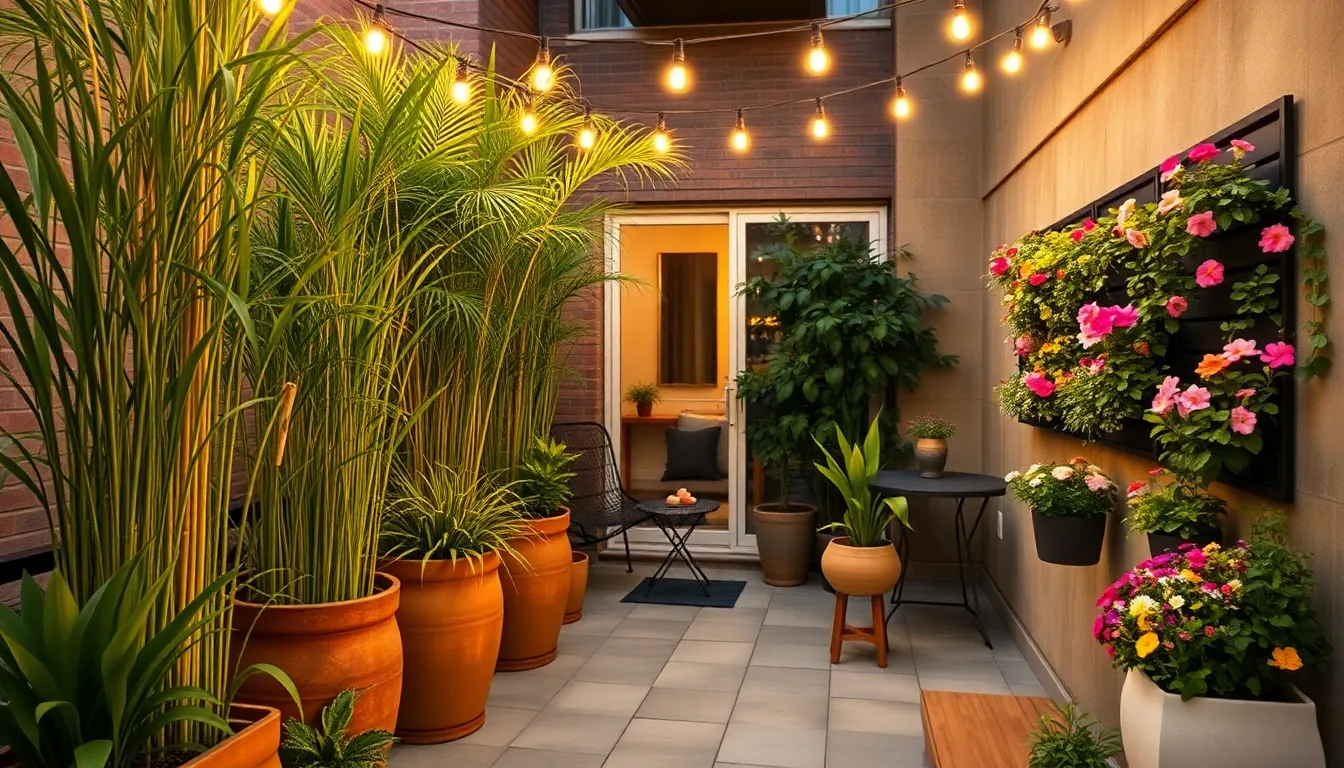
After selecting the perfect low-maintenance plants for our patio, we’ll need to arrange them strategically to maximize both privacy and visual appeal.
Use Tall Plants and Screens for Natural Privacy Barriers
Incorporate tall planters with bamboo or grasses to create effective privacy screens that block unwanted views from neighbors. These lightweight composite or resin planters keep weight manageable while providing the height we need for natural barriers. Positioning them along the perimeter of our patio transforms the space into a secluded retreat.
Install vertical garden planters that serve dual purposes by adding privacy height and increasing our growing capacity. Multi-level planters maximize space efficiency while creating natural walls of greenery. Attaching these systems to walls or railings helps us use every vertical inch without cluttering floor space.
Train climbing plants on trellises attached to balcony railings for additional green coverage and texture. Chicken wire or mesh systems support climbing greenery that creates living privacy screens. These vertical elements add lushness at eye level while maintaining our patio’s open feel.
Mix plant heights strategically by combining tall specimens with medium and low-growing varieties for layered privacy. This approach creates visual depth while ensuring complete coverage at different levels. Grouping plants of varying heights also adds natural texture and movement to our garden design.
Add String Lights and Solar Lanterns for Evening Appeal
Drape string lights along railings and overhead structures to create warm, inviting illumination that extends our patio’s usability into evening hours. This soft lighting adds charm and transforms our garden into a cozy retreat after dark. Strategic placement among plants creates magical shadows and highlights our greenery.
Hang solar lanterns throughout the plant arrangements to provide sustainable, maintenance-free lighting that charges during the day. These fixtures eliminate the need for electrical connections while adding decorative elements to our garden design. Positioning them at varying heights creates layered lighting effects.
Install LED strip lights under planter edges or along vertical structures to highlight our garden’s architectural features. This subtle illumination showcases our plant arrangements while providing functional lighting for evening gardening tasks. Battery-powered options offer flexibility in placement without running cables.
Combine lighting with reflective surfaces like mirrors or metallic planters to amplify the ambient glow throughout our space. This technique makes smaller patios appear larger while maximizing our lighting investment. Reflective elements also add visual interest during daylight hours.
Design Multi-Functional Furniture for Small Patio Gardens
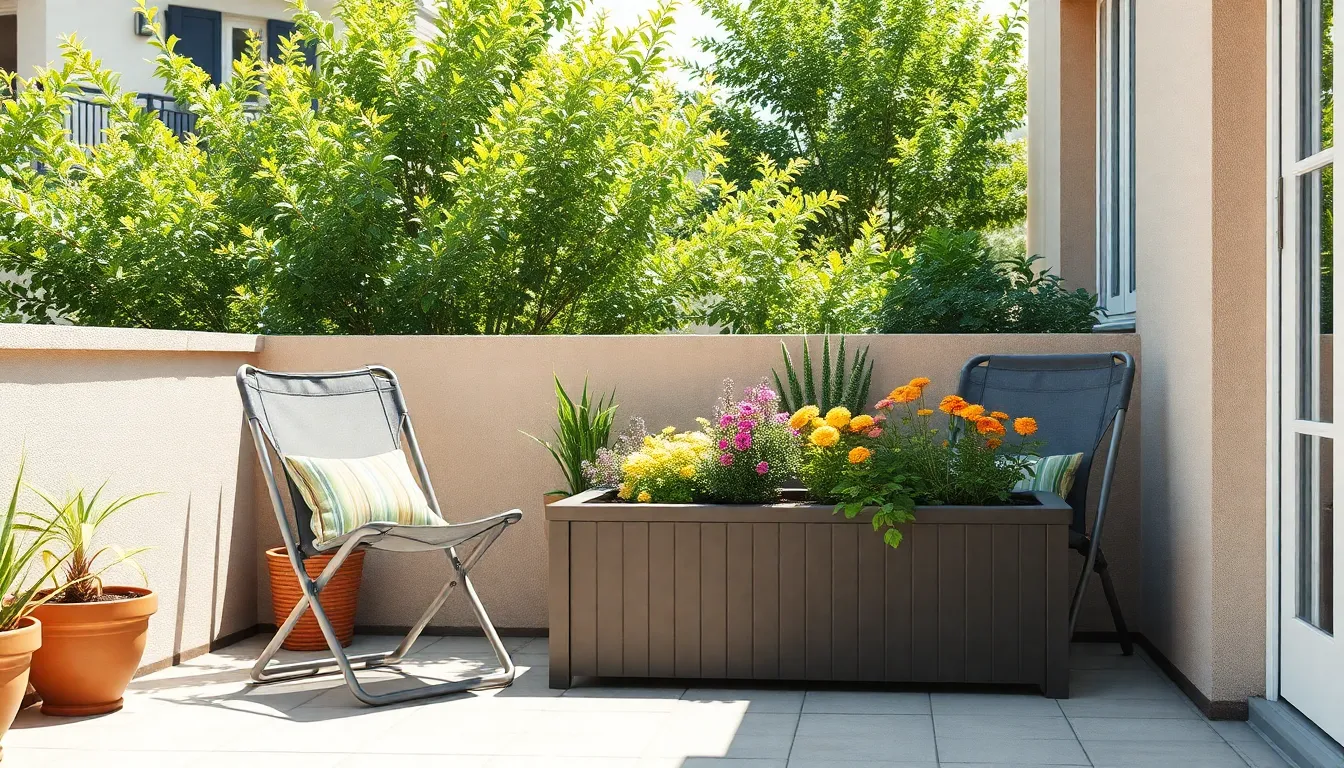
Smart furniture choices can double your patio’s functionality while maintaining an organized garden space. Multi-functional pieces help us achieve both storage and seating without sacrificing precious square footage.
Incorporate Storage Benches and Planter Combos
Storage benches combined with planters effectively use limited space by integrating seating with greenery. We can keep gardening tools, cushions, and smaller pots neatly tucked away inside these benches while enjoying comfortable outdoor seating. These arrangements create vertical layering of plants that enhances visual appeal and greenery density within our small footprint.
Built-in planter combos allow us to organize plants and garden supplies without occupying extra floor area. Garden centers now offer weather-resistant storage benches that double as plant stands, maximizing both growing capacity and functionality. We’ll find these pieces contribute to maintaining a clutter-free environment that makes our patio feel more spacious and suitable for dining or relaxing activities.
Choose Foldable and Stackable Garden Furniture
Foldable chairs and tables provide excellent flexibility for small patios because they store easily when we’re not using them. This approach frees up space for active gardening or leisure activities throughout different times of day. We can quickly transform our patio from a working garden space into an entertaining area for guests.
Stackable furniture offers similar benefits by allowing compact storage while preserving functionality as needed. These pieces adapt our patio into a versatile extension of our living area that works for gardening, dining, or hobby activities. Lightweight aluminum and resin materials make moving and storing these furniture pieces effortless while withstanding outdoor weather conditions year-round.
Establish Efficient Watering and Drainage Systems
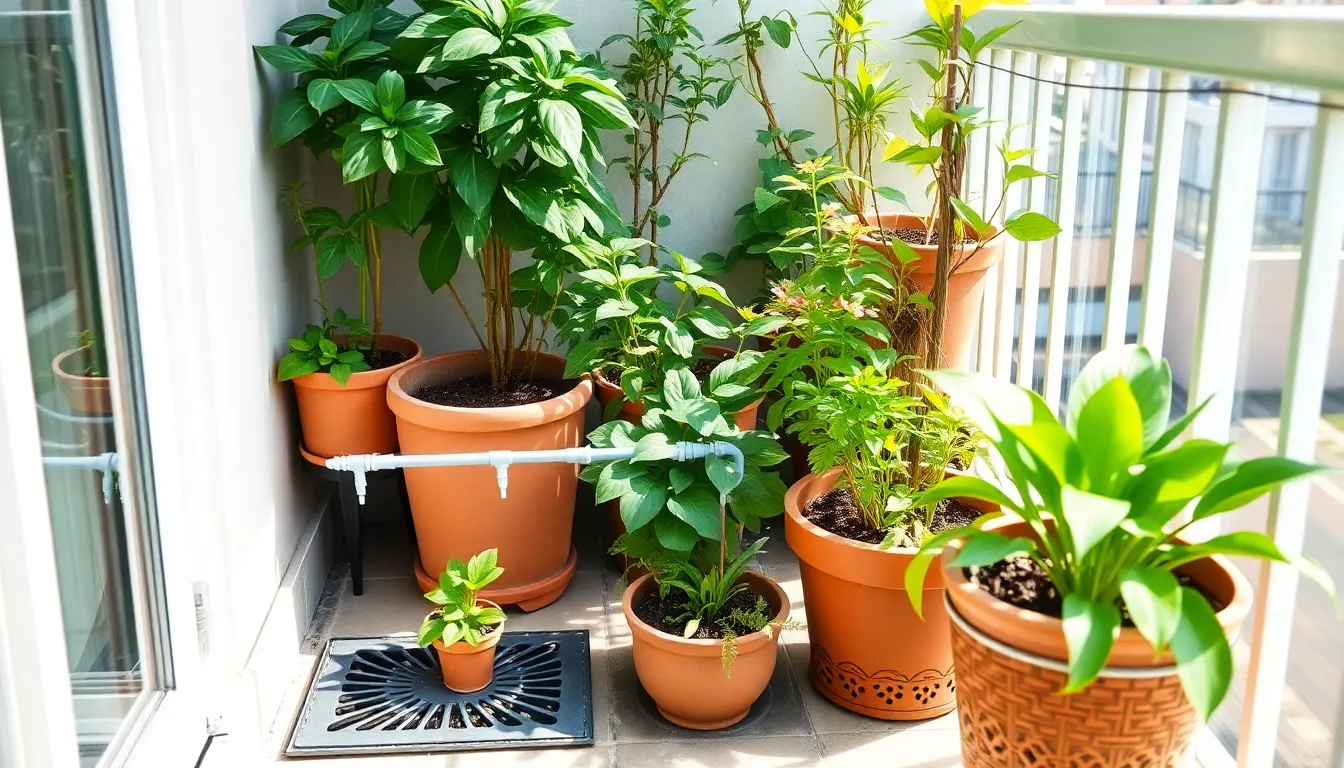
Smart watering and drainage answers keep our apartment patio gardens thriving while protecting both plants and living spaces. These essential systems prevent plant loss and property damage while making garden maintenance effortless.
Set Up Drip Irrigation for Container Gardens
Drip irrigation systems deliver water directly to plant roots, minimizing waste and maximizing efficiency. We can install these automated systems specifically for container gardens where space is limited. The targeted water delivery ensures each plant receives adequate moisture without oversaturating surrounding areas.
Automated drip irrigation prevents overwatering while saving valuable time. Setting up timers allows us to maintain consistent watering schedules even when we’re away from home. This automation is particularly beneficial for balcony and patio container gardens where manual watering can be inconsistent.
Installation involves connecting tubing from a water source to individual containers. We can customize the system by adjusting flow rates for different plant types and container sizes. The flexibility allows us to water herbs differently than flowering plants or vegetables.
Vertical garden structures integrate seamlessly with drip irrigation systems. Running irrigation lines along vertical planters and wall mounted containers creates efficient watering throughout our entire garden setup. This integration maximizes both space utilization and water management.
Ensure Proper Drainage to Protect Your Patio Floor
Proper drainage prevents water pooling that damages flooring and creates safety hazards. We must use containers with adequate drainage holes and place waterproof saucers underneath to catch excess water. This protection keeps our patio surfaces safe from water damage and slip risks.
Elevating containers slightly improves water flow and prevents moisture trapping. Raising pots on small feet or blocks allows air circulation underneath while ensuring proper drainage. This elevation technique protects both plant roots and patio surfaces from prolonged moisture exposure.
Strategic placement of drainage trays maintains cleanliness while protecting surfaces. We can choose decorative saucers that complement our garden aesthetic while serving practical purposes. These trays should be emptied regularly to prevent standing water that attracts pests or creates odors.
Weight distribution considerations help prevent structural damage to balconies and patios. Using lightweight containers and proper drainage materials reduces overall load while maintaining effective water management. This approach ensures our garden remains safe and sustainable within apartment living constraints.
Add Seasonal Interest With Rotating Plant Displays
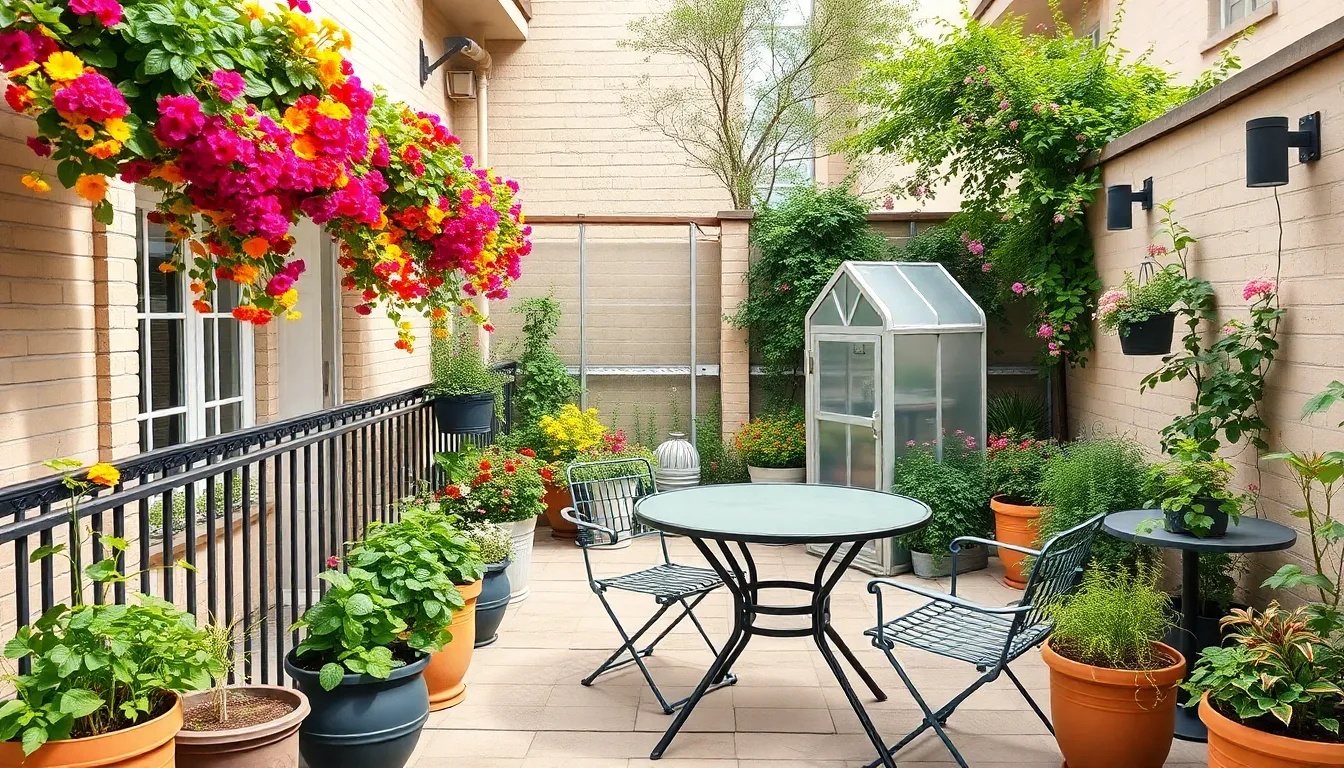
Seasonal rotation transforms our apartment patio into a ever-changing garden that captures the beauty of each season. This strategic approach ensures our outdoor space remains vibrant and captivating throughout the year.
Plan Spring and Summer Flowering Arrangements
Bright cascading flowers create stunning displays when positioned over railings during warmer months. We can maximize our sunny spots by growing heat-loving herbs like basil, oregano, and mint in containers or vertical herb gardens that thrive in warm weather conditions.
Flowering annuals bring continuous color and fragrance to our patio throughout spring and summer seasons. These plants work perfectly in lightweight containers that we can easily rearrange as needed for optimal sun exposure.
Compact greenhouses or protective covers extend our growing season while safeguarding delicate flowering plants from unexpected wind and rain. This protection allows us to start our spring displays earlier and maintain summer blooms longer than traditional outdoor growing would permit.
Flexible outdoor furniture transforms our patio into a multifunctional space where we can tend our flowering arrangements while enjoying dining al fresco or relaxing among our blooms.
Transition to Fall and Winter Hardy Plant Options
Hardy plants and small shrubs resist cold temperatures and strong winds that characterize fall and winter months. Dwarf olive trees add structural interest with their distinctive silver foliage that remains attractive even during colder seasons.
Evergreen shrubs in containers tolerate low temperatures and reduced sunlight while maintaining visual appeal outside the traditional growing season. These container-friendly options ensure our patio garden doesn’t become barren during harsh weather conditions.
Uplighting at night creates ambient atmosphere around our hardy winter plants, transforming our patio into an inviting evening retreat. This technique highlights the structural elements of dwarf trees and shrubs we’ve selected for cold weather resilience.
Small trees and hardy shrubs provide year-round backbone structure that supports our rotating seasonal displays. These permanent fixtures anchor our design while allowing flexibility for seasonal plant changes around them.
Budget-Friendly DIY Projects for Apartment Patio Gardens

Creating stunning apartment patio gardens doesn’t require expensive equipment or professional landscaping services. We can transform ordinary household items and basic materials into functional garden elements that maximize our growing space while staying within budget.
Repurpose Household Items as Creative Planters
Transforming everyday containers into unique planters offers endless possibilities for apartment gardeners. Old jars, cans, buckets, and wooden crates become charming plant homes when we add drainage holes and decorative touches like paint or twine wrapping.
Vertical growing systems work exceptionally well when we attach repurposed containers to walls or balcony railings. Plastic bottles cut in half create perfect herb planters that save floor space while adding greenery to unused vertical areas.
Wooden pallets transform into rustic wall-mounted plant holders or small raised beds with minimal effort and cost. We can paint them to match our patio’s color scheme or leave them natural for an authentic farmhouse aesthetic.
Large containers like old buckets or storage bins accommodate multiple plants when we create dividers using smaller pots inside. This approach maximizes our planting capacity while maintaining organized growing zones for different plant types.
Build Simple Garden Structures Using Affordable Materials
DIY trellises constructed from inexpensive wood or repurposed materials support climbing plants while adding privacy and vertical interest to our balconies. Basic lumber from hardware stores costs significantly less than pre-made garden structures yet provides the same functionality.
Fence panels or lattice screens purchased at budget prices create effective privacy barriers that define our garden areas and block unsightly views. We can mount these panels to existing railings or create freestanding screens using simple wooden frames.
Plant stands made from basic wood or cinder blocks elevate our containers to create diverse height layers throughout the patio space. Stacking cinder blocks requires no tools while providing sturdy platforms that organize our garden vertically.
Lightweight planters constructed from resin, vinyl, or plastic materials prevent weight restrictions from limiting our gardening ambitions. These materials cost less than ceramic or stone alternatives while offering durability and easy mobility for seasonal rearrangements.
Hanging systems using rope, chains, or brackets maximize our usable space without cluttering floor areas. Simple pulley systems allow us to raise and lower planters for easy maintenance while creating ever-changing visual displays that change throughout the growing season.
Conclusion
Creating a stunning patio garden in your apartment doesn’t require a massive budget or extensive gardening experience. With the right combination of vertical growing techniques smart plant selection and creative DIY answers we can transform even the smallest outdoor spaces into thriving green sanctuaries.
The key lies in maximizing every square inch through strategic planning and thoughtful design choices. By incorporating efficient watering systems proper drainage and seasonal rotation strategies we ensure our gardens remain beautiful and productive year-round.
Remember that successful apartment patio gardening is about working with what you have and making smart choices that fit your lifestyle. Whether you’re growing fresh herbs for cooking or creating a peaceful retreat these techniques will help you cultivate the perfect outdoor oasis right outside your door.
Frequently Asked Questions
Can I really create a garden on my apartment patio?
Absolutely! Even small patios can be transformed into beautiful garden spaces using container gardening, vertical growing systems, and creative plant arrangements. The key is maximizing your available space through strategic planning and selecting plants that thrive in containers.
What should I consider before starting my patio garden?
Assess your patio’s dimensions, sunlight conditions, and weight restrictions. Document microclimates and utility access points to plan your layout efficiently. Understanding these factors will help you choose the right plants and containers for your specific space.
Which plants are best for low-maintenance patio gardens?
Hardy herbs like rosemary and garden sage require minimal care. For vegetables, try cherry tomatoes, peppers, and lettuce. Flowering plants like succulents, lavender, and hydrangeas add color without demanding extensive maintenance. These plants thrive with basic watering and occasional deadheading.
How can I maximize growing space on a small patio?
Use vertical gardening techniques like wall-mounted planters, hanging baskets, and DIY garden towers. Transform balcony railings into plant supports and utilize trellises for climbing plants. Lightweight containers allow easy rearrangement while maximizing every inch of available space.
What are some budget-friendly DIY patio garden ideas?
Repurpose household items like jars, cans, and wooden crates as planters. Create DIY trellises from affordable materials and build simple vertical growing systems. These cost-effective solutions help you create beautiful gardens without expensive equipment while reflecting your personal style.
How do I create privacy on my patio garden?
Use tall plants like bamboo or ornamental grasses as natural privacy screens. Train climbing plants on trellises and mix plant heights for visual depth. Combine these with strategic lighting like string lights or solar lanterns to create a cozy, private retreat.
What’s the best way to water my patio garden?
Set up drip irrigation systems for consistent, efficient watering. Ensure proper drainage with containers that have drainage holes and waterproof saucers. Elevate containers and use drainage trays to protect surfaces while preventing water pooling that can damage plants and flooring.
Can I maintain a patio garden year-round?
Yes! Plan seasonal rotations with spring/summer flowering plants and heat-loving herbs. For fall/winter, choose hardy plants and small shrubs that withstand cold temperatures. Use compact greenhouses to extend growing seasons and uplighting to maintain visual appeal during colder months.

